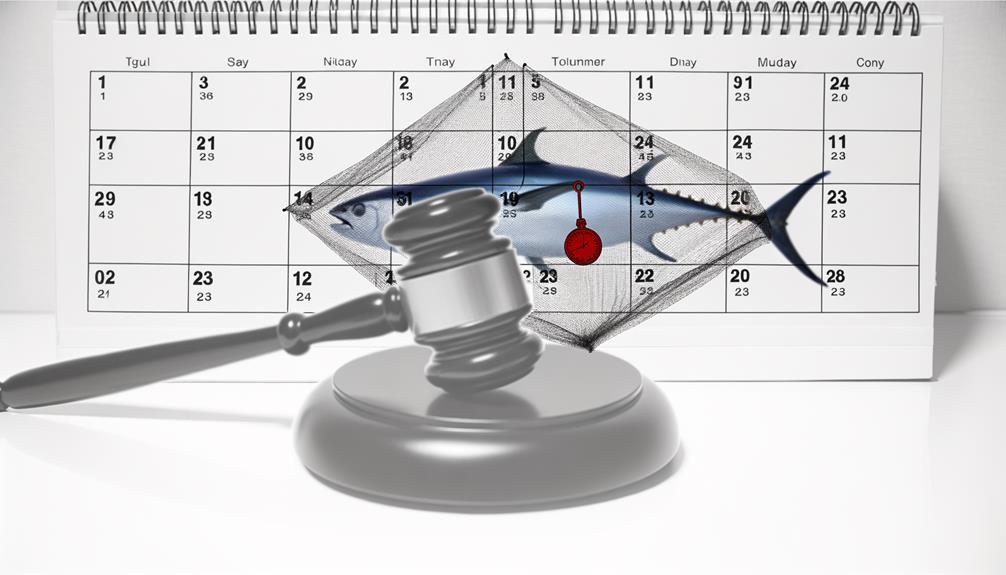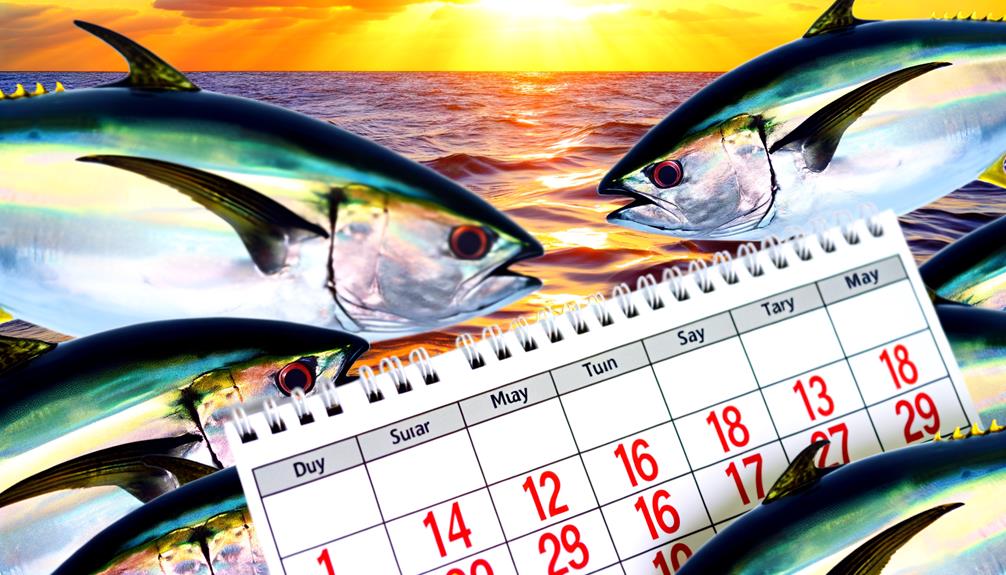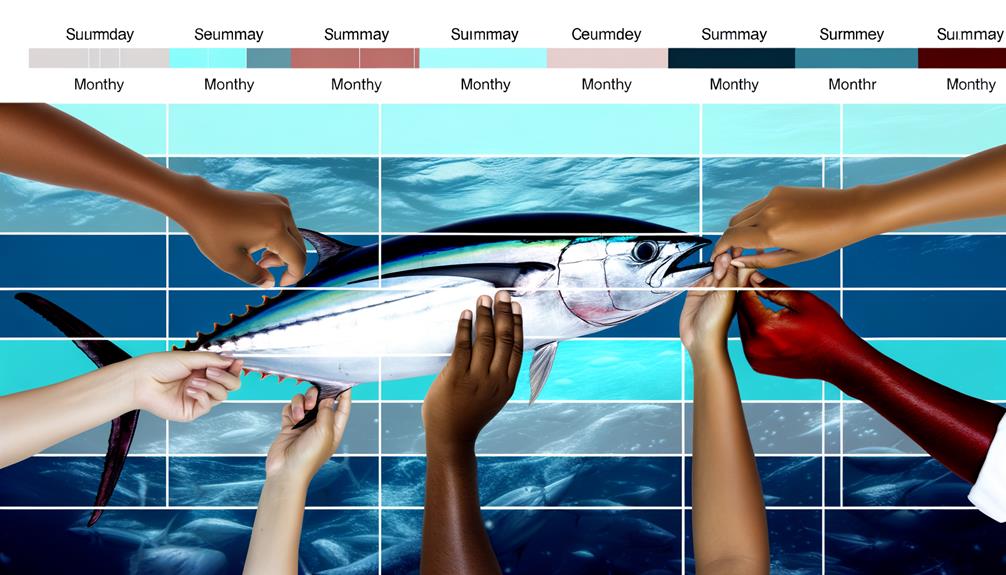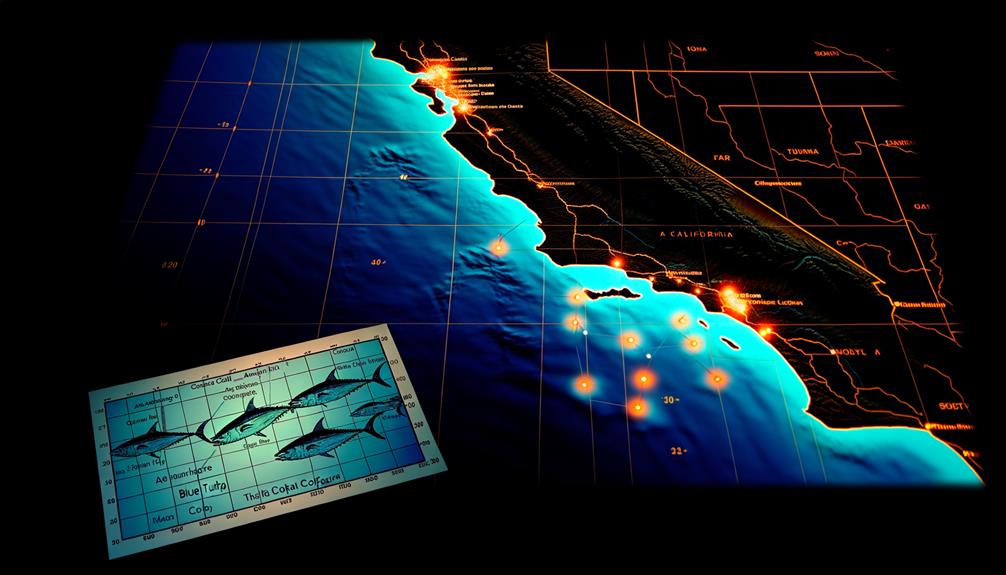As the old saying goes, 'Knowledge is power.' So, let's empower you with some inside information on the Bluefin season.
You're likely aware that the timing of Bluefin season can significantly influence the success of your fishing endeavors. However, it's not as simple as marking a date in your calendar. Factors such as location, species, and even regulatory measures play a critical role in determining that opportune moment.
Now, wouldn't you like to know more about these variables and how they might affect your next Bluefin catch?
Key Takeaways
- The Atlantic Bluefin Tuna season for 2022 runs from July 1 to November 30, with specific dates for Massachusetts and New Jersey yet to be announced.
- Bag limits and permit variations during the season depend on permit type, vessel type, fish size, and fishing region.
- Federal regulations by the National Marine Fisheries Service govern bluefin tuna fishing, and compliance is crucial.
- Bluefin fishing in Massachusetts and New Jersey is regulated by NOAA, and both states emphasize the importance of sustainable practices.
Understanding Bluefin Tuna
To truly grasp the significance of bluefin tuna season, you must first understand the unique biology and behaviors of the Atlantic Bluefin Tuna, a magnificent species regulated by the National Marine Fisheries Service. Since the implementation of harvest quotas in 1982, their populations have remained stable, a testament to the efficacy of these regulations.
Understanding bluefin tuna involves more than just knowing their season. It's about appreciating their unique biology, studying their behavior, and being aware of the regulations in place to protect them.
The Atlantic Bluefin Tuna season for 2022, for example, commences on July 1 and concludes on November 30. This period is meticulously calculated based on their breeding and migration patterns.
Moreover, fishing locations like Massachusetts and New Jersey are recommended based on the tuna's habitat preferences, ensuring you have a successful bluefin tuna season. The zero retention limits on specific days between July and November of 2023 further emphasize the care taken to manage this precious resource.
Atlantic Bluefin Season 2022
Diving into the Atlantic Bluefin Tuna Season of 2022, it's essential to note that the season kicked off on July 1 and will wrap up on November 30, contingent on the annual quota being met. You, as an angler or aficionado, need to understand the nuances that define this season and its regulatory framework.
Key factors to keep in mind include:
- Bag limits during the Atlantic Bluefin Season 2022, which are contingent on:
- The type of permit you hold
- Your vessel type
- The size of the fish
- The region where you're fishing
The season's relevance to the Atlantic Bluefin Tuna population underscores the importance of sustainable fishing practices.
The yet-to-be-announced specific dates for the Massachusetts and New Jersey bluefin tuna season within the Atlantic Bluefin Season 2022.
These details paint a picture of a tightly regulated, scientifically managed fishery, ensuring a sustainable future for the Atlantic Bluefin Tuna.
Regulatory Measures for Bluefin

Now that you're familiar with the Atlantic Bluefin Season's intricacies, let's navigate through the regulatory measures for Bluefin, a critical component ensuring the sustainability of this marine species. The regulatory measures for bluefin, such as bag limits, harvest quotas, and restricted fishing days (RFDs), are intricate systems designed to balance the demands of bluefin tuna fishing with the need to preserve the species.
Let's delve into the specifics:
| Regulatory Measure | Description |
|---|---|
| Atlantic Bluefin Tuna Season | Runs from July 1 to November 30, may close earlier if quota is met. |
| Bag Limits and Permit Variations | Vary based on permit, vessel type, fish size, and region. |
| Harvest Quotas and Equipment Requirements | Introduced in 1982 to ensure sustainability. Specific equipment required. |
| Restricted Fishing Days (RFDs) | Specific RFD schedules established. Zero retention limits on certain days. |
| Federal Regulations and Compliance | Regulated by the National Marine Fisheries Service. Compliance crucial. |
Understanding and adhering to these measures isn't just a matter of law, it's a commitment to the future of the bluefin tuna and the ecosystem they inhabit. You're part of a community that respects and protects our oceans.
Bluefin Fishing in Massachusetts
If you're planning a fishing trip in Massachusetts, you should know that the 2022 Atlantic Bluefin Tuna season kicked off on July 1 and is slated to close on November 30, although it might wrap up earlier if the annual harvest quota is reached.
To enhance your experience, assimilate the following:
- Regulations: Bluefin fishing in Massachusetts is regulated by NOAA. Bag limits vary based on:
- Size
- Quantity
- Permit
- Vessel type
- Locations: The state offers ideal offshore areas with deep ledges and banks. Cape Cod and Ipswich are particularly recommended for Bluefin fishing.
- Sustainability: Specific dates for the season haven't been announced yet, underlining the commitment to prevent overharvesting and promote sustainable practices.
These guidelines ensure that you're not only having a memorable fishing experience but also playing a part in protecting the Bluefin population for future generations.
New Jersey's Bluefin Bounty

In the heart of New Jersey, you'll find an abundant Bluefin bounty, with the season's specific dates for 2022 yet to be announced. This state's waters are a haven for tuna, particularly the Bluefin variety. You're part of a community that values both the thrill of the hunt and the preservation of this magnificent species.
NOAA regulates the bag limits for Bluefin in New Jersey, basing their decisions on size and quantity to promote sustainable fishing practices. It's a fine balance, one that ensures future generations can also experience the exhilaration of landing a Bluefin.
The town of Cape May, nestled in southern New Jersey, is a prime spot for accessing offshore drop-offs where the Bluefin roam. You're not just a fisherman here; you're a custodian of the deep, exploring underwater canyons teeming with various tuna species.
New Jersey's Bluefin bounty is more than a seasonal event; it's a testament to the enduring allure of these marine giants. So, gear up, get out there, and make the most of this Bluefin bounty. You're a vital link in a chain that stretches from the past and into the future, furthering the legacy of New Jersey's Bluefin tuna.
Pacific Bluefin Season Overview
You'll find that the Pacific Bluefin season generally spans from May to October, with slight variations depending on location and local restrictions.
How the season impacts the Bluefin population is a critical point of discussion, as it's managed to encourage sustainable fishing practices.
Your success in fishing Pacific Bluefin hinges on understanding the optimal time, method, and place for this activity.
Season Duration and Timing
For successful Pacific Bluefin Tuna fishing, it's crucial to understand the seasonal patterns, notably that the season generally runs from May to October, with fluctuations depending on regulations and stock assessments.
To help you plan your fishing trips, here is a breakdown of the season:
- May to October: This is the usual Pacific Bluefin Tuna season.
- Specific start and end dates may vary annually due to changes in regulations and stock assessments. Always stay updated on these changes.
- Optimal fishing time typically happens during the summer months when the water temperature is warmer.
Impact on Bluefin Population
While understanding the timing and duration of the Bluefin season is key to successful fishing, it's equally important to consider the impact the season has on the Pacific Bluefin Tuna population.
You should know that the season typically runs from May to November, but can close earlier if the fishing quota is met. This is a measure to prevent overfishing and ensure the sustainability of tuna populations.
Harvest quotas and regulations have been instrumental in stabilizing Pacific Bluefin tuna populations, particularly in key fishing regions like California and Baja California.
The season's impact on Bluefin population is closely monitored to maintain long-term sustainability and conservation efforts. By respecting these guidelines, you're playing a crucial role in preserving this valuable species.
Managing Pacific Bluefin Tuna

You're navigating the complex task of managing Pacific Bluefin Tuna, a process that heavily emphasizes conservation. Understanding the impact of fishing regulations on this species isn't just important, it's crucial for their survival.
Let's examine the sustainable harvesting techniques that work to minimize overfishing and maintain a healthy population of these marine creatures.
Pacific Bluefin Tuna Conservation
In managing the Pacific Bluefin Tuna population, conservation strategies play a pivotal role. Measures including rigorous regulations, quotas, and sustainable fishing practices are all designed to prevent overfishing and ensure the species' survival. These strategies are crucial, especially within the United States' jurisdiction.
Pacific Bluefin Tuna Conservation methods involve:
- Implementing strict quotas to limit catch sizes and prevent overfishing
- Enforcing regulations that promote sustainable fishing practices
- Monitoring and managing the Pacific Bluefin Tuna population to ensure its long-term survival
Fishing Regulations Impact
Understanding how fishing regulations impact the management of the Pacific Bluefin Tuna becomes crucial as we delve into the specifics of various fishing seasons and practices.
The Tuna Fishing Season, which varies regionally, is strictly regulated to prevent overfishing, a result of the Bluefin's popularity among commercial and recreational fishers. These regulations include harvest quotas, specific equipment requirements, and bag limits based on permit type and fish size.
In locations like Cape Cod and Cape May, these rules are enforced to maintain a balance between the industry's economic benefits and the species' sustainability. Consequently, the fishing regulations impact not only the length of the Bluefin season but also the survival of this magnificent species.
This intricate management system ensures you'll be able to enjoy Bluefin fishing for generations to come.
Sustainable Harvesting Techniques
Building on the premise of fishing regulations, let's now explore the sustainable harvesting techniques employed in managing Pacific Bluefin Tuna populations. When you catch bluefin tuna, these techniques ensure the longevity of the species.
Here are three key sustainable harvesting techniques:
- *Harvest Quotas:* These limit the amount of Bluefin that can be caught, preserving population levels.
- *Equipment Requirements:* Specific gear is mandated to prevent overharvesting.
- *Weak Hooks Usage:* Longline fishing operations use these to minimize bycatch.
These measures, coupled with strict regulations, ensure Atlantic bluefin tuna season upholds sustainable fishing practices.
California's Bluefin Hotspots

If you're planning a bluefin tuna fishing adventure, California should be your go-to destination from May to October, with hotspots like San Diego, Los Angeles, and Santa Barbara offering excellent opportunities. These California's bluefin hotspots are teeming with tuna, attracting both novice and seasoned anglers alike.
In San Diego, tuna can be found in abundance, thanks to the area's favorable oceanic conditions and rich biodiversity. Similarly, the coastal regions of Los Angeles and Santa Barbara are renowned for their high bluefin tuna populations. Here, the nutrient-rich Pacific waters create an ideal environment for bluefin, increasing your chances of a successful catch.
However, it's important to note that the specific dates for the 2022 California bluefin tuna season haven't been announced yet. Despite this uncertainty, California's commitment to sustainable fishing practices ensures that measures are in place to protect the bluefin population.
Insights From 'Wicked Tuna
While the California bluefin tuna season's specifics remain undisclosed, you can gain intriguing insights into the intense world of tuna fishing through the popular reality show 'Wicked Tuna'. This real-life drama showcases the triumphs and challenges faced by the Gloucester fishermen within the 14-week bluefin tuna season.
It's a race against time, with each of the 23 fishing days being crucial. The intense pressure results from the potentially high value of each catch, ranging from $10,000 to $20,000. This competitive environment fosters real rivalry and the elbowing for a substantial paycheck. The overfishing regulations limit them to a three-fish quota per day, adding to the uncertainty of income.
The unpredictability of the season's yield is a source of stress for these fishermen, who rely on these catches as their sole income source. Each fish caught is more than just a paycheck; it's the means to provide for their families and educate their children.
'Wicked Tuna' offers a glimpse into the captivating, yet challenging, world of tuna fishing, creating a sense of belonging among its viewers.
Frequently Asked Questions
How Long Is Bluefin Tuna Season in Gloucester?
You're wondering about bluefin tuna season in Gloucester. Well, it typically runs from July 1 to November 30. But remember, Gloucester regulations and your tuna fishing techniques can impact the season's length.
How Long Is the Commercial Bluefin Tuna Season in the Outer Banks?
In the Outer Banks, your commercial bluefin tuna season typically starts July 1, ending November 30. However, it'll close early if catch limits are reached. Seasonal impacts regulate this to ensure sustainability.
How Long Is the Tuna Season on Wicked Tuna?
Ever wonder how long the tuna season on Wicked Tuna lasts? It's not set in stone, as regulations and the show's impact can alter it. You're part of a community that respects this ebb and flow.
Is There a Season for Bluefin Tuna in 2023?
Yes, there's a season for Bluefin tuna in 2023. It typically runs from July through November, but it's subject to 2023 regulations and may end early due to sustainability concerns. Stay tuned for specific dates.
Conclusion
In conclusion, managing bluefin tuna seasons is pivotal for sustainability.
Astonishingly, the International Seafood Sustainability Foundation reports that the Pacific bluefin tuna population is at just 2.6% of its historic level.
So, it's imperative to respect season dates and bag limits.
Whether you're angling in Atlantic waters or cruising California's coast, responsible fishing is key.
After all, a healthy bluefin population ensures a thrilling chase for generations of fishermen to come.
